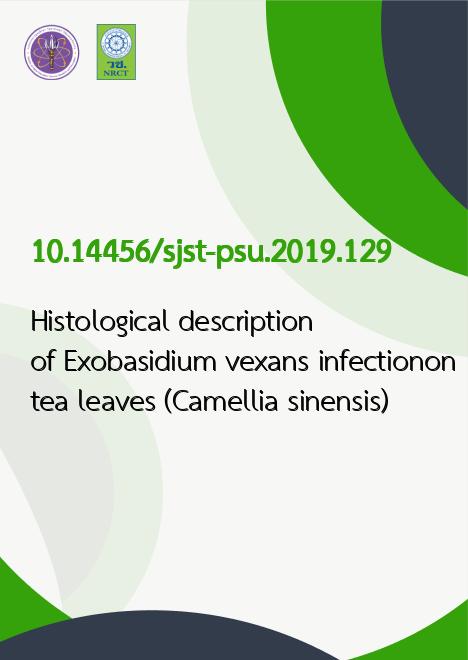
|
Histological description of Exobasidium vexans infectionon tea leaves (Camellia sinensis) |
|---|---|
| รหัสดีโอไอ | |
| Creator | 1. Norsyuhada Mohktar 2. Hideyuki Nagao |
| Title | Histological description of Exobasidium vexans infectionon tea leaves (Camellia sinensis) |
| Publisher | Research and Development Office, Prince of Songkla University |
| Publication Year | 2562 |
| Journal Title | Songklanakarin Journal of Science and Technology |
| Journal Vol. | 41 |
| Journal No. | 5 |
| Page no. | 1021-1028 |
| Keyword | disease severity, leaf galls, cell differentiation, mesophyll, phloem, plant parasite |
| URL Website | http://rdo.psu.ac.th/sjstweb/index.php |
| ISSN | 0125-3395 |
| Abstract | Exobasidium vexans Massee is a parasitic fungus that causes tea blister blight. Tea blister blight is characterized byswelling of infected spots on tea leaves. To date, there is limited information on the cellular alterations that occur during E.vexans infection. This study aimed to observe the histological changes on tea leaves infected by E. vexans. Diseased and healthyleaves were thin-sliced by a cryostat microtome and examined by light microscopy. Observations on the thin sections revealedthe mode of hymenium development in E. vexans in which the basidia protruded between the epidermal cells. The infectioncaused hypertrophy as the size of the cells at the infected spots became double the size of the healthy cells. We also report thefirst description of venous infections of E. vexans. The proliferation of the fungus on the vein resulted in the formation ofhymenium on both the lower and upper sides of the leaves and there was complete disruption of the vascular bundle in the leafveins. Blister blight disease was found to be moderately severe at the tea plantation in this study. Morphological and molecularidentification confirmed that the fungus isolated from the symptomatic leaves was E. vexans. |
